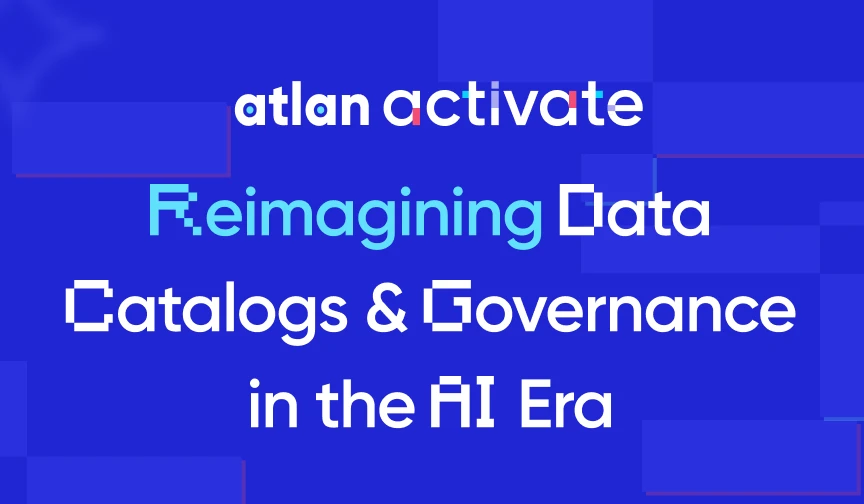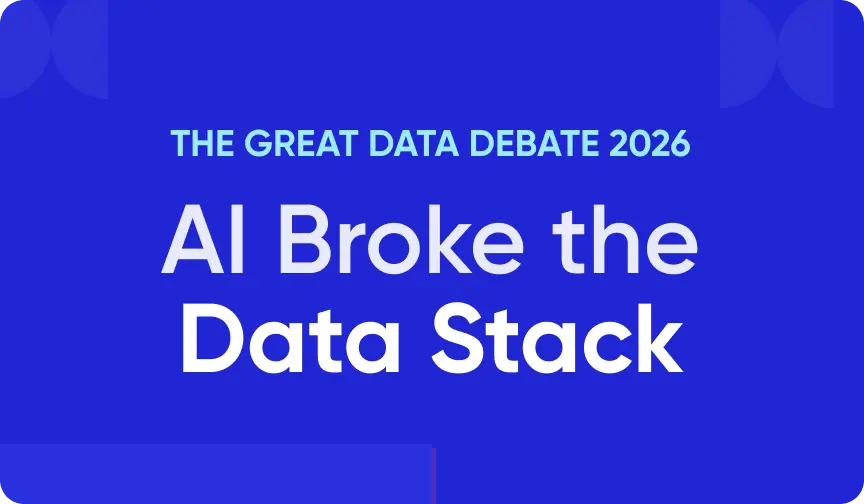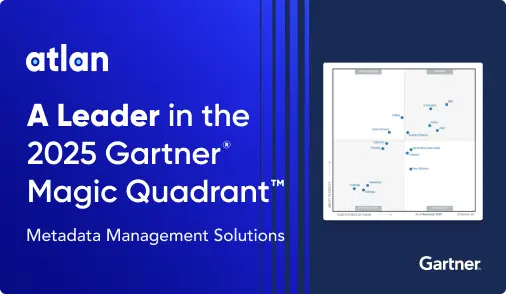Data Governance in M&A Transactions: A 2025 Guide on Managing Risks & Ensuring Compliance

Last Updated on: July 03rd, 2025 | 12 min read
Unlock Your Data's Potential With Atlan

Quick Answer: What is data governance in M&A transactions?
Permalink to “Quick Answer: What is data governance in M&A transactions?”Data governance in M&A transactions refers to the framework and processes that ensure data across merging entities is accurate, secure, accessible, and aligned. It enables organizations to standardize metadata, unify access controls, maintain regulatory compliance, and ensure a trusted data foundation for post-merger analytics and operations.
Up next, we’ll explore the top data-related risks in M&A, how a modern data governance framework can mitigate them, and the role of a metadata control plane in accelerating integration efforts.
Table of Contents
Permalink to “Table of Contents”- Data governance in M&A transactions explained
- What are the most common data-related risks in M&A transactions?
- How can you ensure effective data governance in M&A transactions?
- How can Atlan help with data governance in M&A transactions?
- Data governance in M&A transactions: Final thoughts
- Data governance in M&A transactions: Frequently asked questions (FAQs)
Data governance in M&A transactions explained
Permalink to “Data governance in M&A transactions explained”Summarize and analyze this article with 👉 🔮 Google AI Mode or 💬 ChatGPT or 🔍 Perplexity or 🤖 Claude or 🐦 Grok (X) .
Data governance in M&A transactions plays a vital role in standardizing and integrating metadata, access controls, data quality, and lineage across merging organizations. It lays the foundation for effective data management, system interoperability, regulatory compliance, and maximizing the value of shared data post-transaction.
“Optimized data management involves an early understanding of what happens to the data after a transaction. It implies having the ability to report on the data and respond to third parties like government officials, if needed. It also means having a coherent and well-understood framework, which organizations can tap to find evidence of what was received and divested.” - Deloitte on the importance of data management during M&A
Why does data governance matter during mergers and acquisitions (M&A)?
Permalink to “Why does data governance matter during mergers and acquisitions (M&A)?”Mergers and acquisitions (M&A) involve two or more companies merging to form a new legal entity or one or more companies being acquired and subsumed by another. The process is long, multi-phased, and complex, which involves:
- Preliminary review
- Negotiations
- Due diligence
- Further negotiations and closing
- Post-closure implementation
One of the most important aspects to address during these phases, especially during and after due diligence, is to identify risks and develop a framework for data governance.
Some of the issues you might face include:
- A fragmented data ecosystem, causing inconsistencies, duplication, and access issues across the business
- Poor data migration, which can corrupt data and affect business operations
- Incompatible systems can cause operational hiccups and affect overall productivity,
- Mishandling PII data can lead to hefty non-compliance fines
Failing to address data governance directly can lead to unfavorable M&A transactions, resulting in substantial losses for an organization due to regulatory non-compliance, data quality issues, and other related problems.
In the last decade, several major M&A transactions, including those involving companies such as Marriott, Verizon, and Yahoo!, among others, have either triggered a deal price reduction or a deal call-off due to concerns over data governance and privacy.
For instance, Verizon was supposed to acquire Yahoo! for $4.48 billion in 2017. The process unearthed privacy nightmares, such as two separate data breaches suffered by Yahoo!, which weren’t disclosed publicly. While Verizon went ahead with the acquisition, they reduced $350 million from their original offer price and agreed to share legal liability for the breaches.
The Verizon-Yahoo! incident has made due diligence more stringent, with increased scrutiny on what personal data gets acquired and how it’s protected.
What are the most common data-related risks in M&A transactions?
Permalink to “What are the most common data-related risks in M&A transactions?”There are many data-related risks that can derail the M&A process, particularly around data quality, data ownership, regulatory requirements, and information about previous data breaches.
While there are several dozen of these data-related issues, those related to data governance typically fall into three categories:
- Operational risks
- Compliance risks
- Due diligence risks
1. Operational risks
Permalink to “1. Operational risks”Merging two organizations often means dealing with incompatible data systems, inconsistent formats, and duplicate records. Without governance, this can lead to:
- Poor data quality and missing context
- Broken analytics and reporting post-merger
- Inefficient business processes and team frustration
2. Compliance risks
Permalink to “2. Compliance risks”Each party may be subject to different legal frameworks (e.g. GDPR, HIPAA, CCPA). Failing to reconcile compliance practices increases the likelihood of:
- Data privacy violations
- Unauthorized access or data exposure
- Regulatory fines or delays in transaction closure
3. Due diligence risks
Permalink to “3. Due diligence risks”Without clear lineage, documentation, or classification, it’s hard to validate the value of acquired data or assess technical debt. This can result in:
- Inaccurate valuation
- Unexpected integration complexity
- Post-merger surprises and reputational risk
How to address these data issues in M&A transactions
Permalink to “How to address these data issues in M&A transactions”Addressing these risks typically requires you to go in-depth into the business processes, data flows, and technology systems and answer questions, such as:
- What are the core data systems that hold master, reference, and operational data for all the parties involved in the M&A transaction?
- What are the business and data governance processes to tag, classify, and protect data within and outside the company for all of the parties to the M&A transaction?
- What is the level of documentation of the data flows, data quality processes, and overall data maturity for all the parties of the transaction?
- How do users find and use data in each of the parties to the M&A transaction, i.e., how is data ownership managed and data access controlled, and what interfaces and processes do they use?
- What is the level of granularity of data lineage in each of the parties to the M&A transaction? How do users gain access to data lineage, and what are their uses for it?
- What are the security, privacy, and sovereignty controls in place at all of the parties to the M&A transaction? This might be crucial for any cross-region data movement requirements.
- What are the various data sharing practices and protocols, both with internal and external customers, at each of the parties to the M&A transaction?
These questions help reveal gaps early—whether in compliance, architecture, or cultural fit—and guide integration planning.
In the next section, we will examine some of the ways these risks can be mitigated.
How can you ensure effective data governance in M&A transactions?
Permalink to “How can you ensure effective data governance in M&A transactions?”To address all data-related work in an M&A transaction, Moody’s suggests breaking it down into different domains, such as:
- Sales and marketing
- Corporate strategy
- Financial performance
- Risk profile
- Industry research and analysis
In contrast, Allen’s M&A playbook suggests tackling the regulatory landscape and data sharing head-on, and asking questions like:
- How will the regulatory landscape affect this M&A transaction?
- Will sharing data in this transaction create competition issues? What constitutes gun jumping?
- What should warranty and indemnity packages addressing data privacy and security matters look like?
- How will data be separated, shared and protected, while maintaining its integrity?
- If both buyer and seller share the same datasets, how will each party control what the other party can do with such data (for example, cross marketing)?
There are differing perspectives on how to handle these risks, but the key focus areas return to the three categories mentioned earlier – operational, compliance, and due diligence.
7 data governance steps to address M&A transaction risk and ensure business continuity
Permalink to “7 data governance steps to address M&A transaction risk and ensure business continuity”Here are the key steps that are involved in addressing risks across these categories:
- Set up a joint data governance team to establish clear ownership, procedures, and responsibilities for data assets.
- Identify data laws and regulations that need to be complied with, such as GDPR, HIPAA, and CCPA, among others.
- Discover and document systems and data assets in a user-friendly, searchable data catalog. Make sure that it’s searchable (even for non-technical users) and creates a shared view of data assets across systems.
- Identify all data privacy, security, and protection measures. This is crucial for applying tags, policies, and security measures that restrict access and support legal compliance.
- Bring crucial data from both systems together into a common foundation. Make sure you prioritize integration for high-impact domains like finance, customer, or product data.
- Set up governance processes and guardrails for data protection during the transaction. Automate access reviews, metadata change approvals, and policy enforcement.
- Document post-merger integration processes. Define lineage, rules, owners, and escalation paths to support ongoing trust and transparency.
Dealing with data and process siloes during mergers and acquisitions
Permalink to “Dealing with data and process siloes during mergers and acquisitions”The companies involved in the M&A transaction, typically, would have data silos of their own, and the M&A transactions would introduce even more silos if some of the fundamental problems are not resolved. Having data in silos is not necessarily a problem if you can search, discover, and access all your data easily.
However, that can’t happen unless there is a thread of metadata tying all the different source systems together — a metadata control plane. It allows you to centrally manage several aspects of data governance, such as:
- Ownership
- Access
- Compliance policies
- Privacy and protection measures
- Data quality metrics
Atlan is a platform built on a metadata control plane. Let’s examine how it can help mitigate data governance risks in M&A transactions.
How can Atlan help with data governance in M&A transactions?
Permalink to “How can Atlan help with data governance in M&A transactions?”Data privacy and security make or break mergers and acquisitions, which is why Atlan takes a security-first approach to everything from data and metadata persistence to authentication and authorization.
Atlan is also compliant with some of the key IT processes and data standards like GDPR, HIPAA, and ISO 27001, among others, which you can access at Atlan’s Trust Center. These are the strong foundations upon which Atlan’s metadata control plane rests, providing a host of data governance and security features for your data estate. Some of those key features are listed below:
- Automated data governance with governance workflows to manage access, control metadata changes by role, and enforce compliance through repeatable, auditable processes.
- Automated policy compliance for ensuring your data meets quality, privacy, security, and lifecycle standards to align with laws like GDPR, HIPAA, and CCPA.
- Granular permissioning using Personas and Purposes to let you fully control who accesses metadata, data, and glossary terms. Atlan integrates with your IdP via SSO and SCIM for system-wide consistency.
- Tags allow you to classify data assets within Atlan. Tags can be based on common data protection schemes like Public, Internal, Restricted, and Confidential. You can also sync tags bi-directionally with some of the source systems using Atlan, which avoids rework and maintains consistent classifications across your stack.
- Domains and Owners allow you to define areas of responsibility for certain data assets clearly. So, you can separate concerns based on business units, teams, and environments, among other things. With Domains, you can create domain policies for data access and usage.
Using the features above, you can answer questions about tagging, classification, ownership, privacy, security, lineage, and other aspects, as framed in some of the key data governance questions earlier in the article, all utilizing the metadata foundation provided by Atlan’s metadata control plane.
Also, read → Atlan’s approach to data governance
Data governance in M&A transactions: Final thoughts
Permalink to “Data governance in M&A transactions: Final thoughts”Over the last few years, numerous M&A transactions have been adversely affected by data privacy and security concerns, which, in some cases, have also resulted from unreported data breaches.
To ensure your organization is ready for the upcoming M&A activity, it is essential to have well-defined data assets, along with their corresponding governance processes and protocols, in place. Once that’s done for the participating companies separately, the processes of due diligence, data validation, and discovery become significantly easier.
By investing in strong governance frameworks and tools like Atlan, data and IT leaders can:
- Reduce compliance and operational risks
- Streamline data integration
- Build trust across merging teams
- Set up shared data for business success
Instead of treating governance as a checklist during due diligence, make it the foundation for a smoother, safer, and smarter merger.
Data governance in M&A transactions: Frequently asked questions (FAQs)
Permalink to “Data governance in M&A transactions: Frequently asked questions (FAQs)”1. What is an M&A transaction?
Permalink to “1. What is an M&A transaction?”A Merger & Acquisition (M&A) transaction is a financial transaction that involves two or more companies integrating to form a single legal entity or to gain a competitive advantage in the market while remaining independent.
2. What is data governance in M&A transactions?
Permalink to “2. What is data governance in M&A transactions?”Data governance in M&A refers to the policies, processes, and tools used to manage data across merging entities. It ensures consistency, compliance, and trust in how data is classified, accessed, and integrated during and after the deal.
3. What is the role of data governance in M&A transactions?
Permalink to “3. What is the role of data governance in M&A transactions?”Data governance is critical for M&A transactions, as it helps protect the data of all participants during the transaction’s critical phases, including due diligence, negotiations, and especially post-merger implementation.
4. What are the biggest data risks in an M&A deal?
Permalink to “4. What are the biggest data risks in an M&A deal?”Key risks include incompatible data systems, undocumented lineage, privacy breaches, lack of access controls, and differing compliance requirements. These can delay integration, increase costs, or reduce deal value.
5. What is the impact of not handling data governance in M&A transactions?
Permalink to “5. What is the impact of not handling data governance in M&A transactions?”Data issues, especially those relating to privacy, security, and compliance, found during the due diligence or even the later stages of the M&A process, can often kill the deal. There have been several cases where M&A deals have fallen through due to unreported data breaches and a lack of data protection measures, among other factors.
6. How does data governance support due diligence?
Permalink to “6. How does data governance support due diligence?”Governance frameworks make it easier to audit data assets, understand data quality and lineage, and assess compliance posture—leading to better-informed decisions and fewer surprises post-deal.
7. When should organizations start thinking about data governance in M&A?
Permalink to “7. When should organizations start thinking about data governance in M&A?”Governance should be embedded early, ideally during due diligence. Waiting until post-merger increases the risk of delays, compliance violations, and unexpected data-related costs.
Share this article
Atlan is the next-generation platform for data and AI governance. It is a control plane that stitches together a business's disparate data infrastructure, cataloging and enriching data with business context and security.
Data governance in M&A transactions: Related reads
Permalink to “Data governance in M&A transactions: Related reads”- What is Data Governance? Its Importance, Principles & How to Get Started?
- Open Source Data Governance Tools - 7 Best to Consider in 2025
- Data Governance Policy: Examples, Templates & How to Write One
- 7 Best Practices for Data Governance to Follow in 2025
- Benefits of Data Governance: 4 Ways It Helps Build Great Data Teams
- Data Governance Roles and Responsibilities: A Quick Round-Up
- AI Data Governance
- Data Compliance Management in Financial Services
- Data Governance and GDPR: What You Need to Know in 2025
- Data Readiness for AI: 4 Fundamental Factors to Consider
- Data Classification and Tagging: How to Marie Kondo Your Data Catalog and Spark Joy
- Automated Data Governance: How Does It Help You Manage Access, Security & More at Scale?
- Enterprise Data Governance Basics, Strategy, Key Challenges, Benefits & Best Practices
- Data Governance in Banking: Benefits, Challenges, Capabilities
- Financial Data Governance: Strategies, Trends, Best Practices
- BCBS 239 Data Governance: What Banks Need to Know in 2025
- Financial Data Compliance Software: What Qualities Matter in 2025
- AI for Compliance Monitoring in Finance: Use Cases & Setup
- Overlapping Compliance Requirements in Banking: What’s the Way Forward?
- Cross-Border Data Transfers: Staying Compliant Globally in 2025
- Unified Control Plane for Data: The Future of Data Cataloging





















